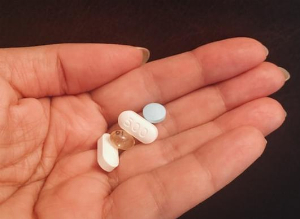A graphene patch that monitors and possibly treats diabetes
Published 6 Apr 2016

Diabetes is growing into a global public health crisis, one that places enormous economic burdens on many nations. Once thought of as a disease that typically strikes affluent adults, type 2 diabetes has quickly spread all over the world, indifferent to socioeconomic status or age.
Treatment of type 2 diabetes requires patients to control their blood sugar levels through a mix of dietary restrictions and medication. Unfortunately, following the progress of these efforts is not as easy as it sounds. Glucose-monitoring devices available on the market typically require the user to obtain a small blood sample that can be read to quantify the level of the sugar. A minimally or non-invasive alternative would probably help many patients stay on top of their health.
Recently, a team of scientists have designed a flexible glucose-monitoring device that conforms to the skin and is barely visible. The device contains an array of sensors that are patterned onto gold-doped graphene and connected by a gold mesh. This setup both improves the electrochemical activity of graphene and enhances the biochemical sensitivity of the system.
How it works
The device is activated when a sufficient amount of sweat is detected. Although diabetes is associated with blood glucose levels, studies have actually shown that these levels can be estimated from precise measurements of sweat glucose concentrations. The readings from the device exhibited a lag time that is consistent with results from previous investigations of sweat glucose (meaning that there's a consistent delay between changes in blood levels and when those changes show up in the sweat).
The device contains the enzyme glucose oxidase, which is able to oxidize glucose and form hydrogen peroxide in the process. The hydrogen peroxide is then involved in another chemical reaction that results in noticeable electrochemical changes, which the glucose and pH sensors measure.
The patch can be connected to a portable electrochemical analyzer that has a dual function: power source and wireless data transmitter. The device is rather user-friendly; the data can be easily sent to a smartphone or tablet.
Not only does the system monitor glucose levels, it also responds to them. Detection of an excess of glucose in the bloodstream (hyperglycemia) triggers the delivery of metformin, a drug commonly used to treat type 2 diabetes.
The drug is delivered through microneedles coated in a layer of tridecanoic acid, a hydrophobic molecule that protects the needles from moisture. Once inserted into the skin, this hydrophobic layer is critical to the prevention of premature metformin release. The patch is embedded with a heater that is triggered by the elevated glucose levels. When it warms the needles, the tridecanoic acid layer shifts, exposing the underlying polymer to the bodily fluids. Metformin is then released from the array of polymeric microneedles in a controlled, stepwise manner.
Device design and characterization
The team paid particular attention to the mechanical properties of the materials used to ensure that they could hold up to the everyday movement of life. They specifically designed the flexibility and mechanical robustness of the system in order to minimize the stresses that occur during mechanical deformations.
The graphene itself is inherently soft. In addition, the scientists used a serpentine design for the gold mesh because this configuration enhances the mechanical deformability of the system. An ultrathin, neutral mechanical plane also helped increase the tolerance of the system to mechanical deformations.
As a biosensor, the electrochemical properties of the system were also critical—they had to hold up to constant contact with the body.
The team also assessed the functionality of the different sensors. They found that the glucose sensor was stable under typical mechanical deformation associated with several movements. Additionally, they found that it was active for a minimum of 24 hours under ambient conditions; depending on the storage conditions, the glucose sensor could be active for several days. The pH and tremor sensors, however, required calibration to function accurately.
Testing the device
The team felt their device was ready for testing. Before slapping it on a human, they checked how it worked using artificial sweat. The glucose and pH sensors were able to measure real-time changes in both these values. They also stimulated hyperglycemia and found that the device was able to detect the elevated glucose levels.
They did find that the glucose sensitivity was dependent on the temperature and was slightly less reliable below room temperature. It might not be as reliable outside on very cold days. Additionally, they explored how the glucose sensor was affected by common drugs. They found that Tylenol, aspirin, and metformin have a minimal impact on its reliability.
Next, the team performed in vivo experiments using mice that had been genetically engineered to develop diabetes. In these studies, they demonstrated that the thermally triggered drug release reduced blood sugar levels in the mice over a period of several hours.
Finally, the scientists performed a proof-of-principle experiment on two men; these patients had no history of heart problems or diabetes. In this experiment, each individual was asked to eat a meal and the device was used to monitor their blood sugar levels. The investigators demonstrated that the device could detect elevated blood sugar levels after eating, and the team then watched as levels dropped back to normal once the subjects' insulin kicked in.
Further studies will help us understand whether this device has the potential for commercialization. Assessing the sensitivity, reproducibility, and reliability of the glucose sensor over longer time periods will be critical. But it would be intriguing if graphene's first big commercial success is in a less invasive treatment for diabetes.
Arstechnica
Comments
You will also like

Diabetes: Discrimination, Professional Life, Plan Ahead... What do patients say?
9 Nov 2018 • 13 comments
Read the article
Read the article

 Facebook
Facebook Twitter
Twitter

